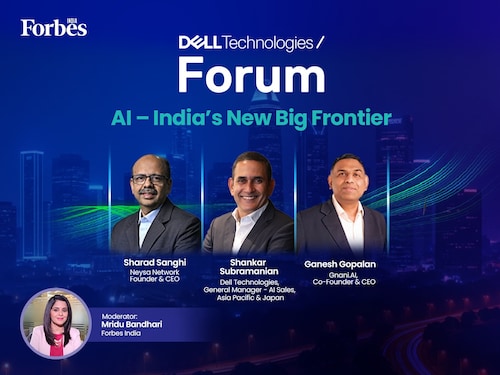Dell Technologies powers India’s AI leap: Building sovereign infrastructure for
AI – India’s new big frontier


India is driving the digital revolution with strategic scale and purpose. By leveraging local-language artificial intelligence, developing smart villages, and advancing space technology, the nation is promoting a people-centric approach to technology that emphasizes ethics, inclusivity, and global relevance.
To highlight this evolution, the Dell Technologies Forum was held in Bangalore. It is the company’s flagship annual event, bringing together IT professionals, technology leaders, and changemakers. Forbes India partnered with Dell Technologies and hosted a session on AI: India’s New Big Frontier, moderated by Mridu Bhandari, Anchor of Forbes India, and featuring Sharad Sanghi, Founder & CEO of Neysa Network, Ganesh Gopalan, Co-Founder & CEO of Gnani.AI, and Shankar Subramanian, General Manager – AI Sales, Asia Pacific & Japan, Dell Technologies.
The discussion moved quickly past product launches and announcements, focusing instead on the foundations of national infrastructure. Artificial intelligence was presented as a utility in the making, one that demands investment in data centers, robust models, and clear governance frameworks. It must be designed to serve people across regions and languages, with the central message that India will build its own intelligence, safeguard it, give it many voices, and deliver it reliably to the last mile.
A key statistic framed the urgency. By 2027, most governments worldwide will require sovereignty as a condition for adopting AI. “That makes purpose-built AI compute in India a national priority,” said Sharad Sanghi, noting that while India has more than 34,000 GPUs in play, “we need far more, supported by sustainable data centers and an ecosystem where local models stand beside global ones.”
Examples kept the conversation grounded. Sanghi pointed to liquid and immersion cooling, which transform heat from a threat into a design opportunity. Shankar Subramanian explained how Dell’s “AI Factory” is structured to help enterprises move from pilots to production: “Start small, scale smart, and build responsibly. AI must be sustainable, profitable, and secure if it is to serve for decades.” The guidance was directed as much to finance chiefs as to technologists: invest in strong foundations, not in scattered parts.
The heart of the discussion turned to India’s most distinct challenge: its data. Here, information is not orderly or uniform but alive. Languages shift every few hundred kilometers. Dialects bend words into new shapes. “The way I speak Tamil is different from Chennai or Bengaluru Tamil,” noted Ganesh Gopalan, stressing the need for vast and diverse datasets. Gnani.AI has built one of the largest annotated voice corpora for Indian languages, but Gopalan insists it is only the beginning: “A few million hours are not enough for a nation of over a billion people.”
He described a pilot in Uttar Pradesh where a conversational agent supports new mothers through the first thousand days, speaking in a cadence that feels closer to a neighbor than a machine. The same principle begins to reshape education. Much of the National Education Policy’s content still exists mainly in English or Hindi, yet true access depends on translation into regional languages, complete with lip-sync and tone, so children can learn in the language they dream in.
Looking ahead, the panel discussed the potential of agentic AI. “We see them as partners, not replacements,” said Subramanian. In sales, they provide insights before a conversation starts. In customer support, they follow up to keep queues calmer. Dell is already working with partners to refine hardware and software systems that enable models built for writing to work alongside those designed for reasoning and acting. The message was clear: plan for production, not just pilots.
Access was treated as part of architecture, not an afterthought. “If you’re in a tier two or tier three city, compute is available,” said Gopalan. Local providers are operational, cloud resources can be reached quickly, and universities are increasingly eager to commercialize. Entrepreneurs solving local problems often discover their solutions map neatly to other parts of the world.
The scale of investment in the region highlights the urgency. Asia-Pacific spending on AI and generative AI is expected to reach $175 billion by 2028, with nearly 40 percent allocated for infrastructure. India produces one-fifth of the world’s data but has only a small portion of its data center capacity. Meeting demand will require significant expansion in compute and storage, supported by hub-and-spoke models and federated learning that protect privacy while boosting collaboration.
India’s AI journey is shifting into a new phase where sovereignty is demonstrated through building robust infrastructure, designing models that capture its linguistic diversity, and forming partnerships that expand opportunity. Intelligence is starting to serve as infrastructure, integrated into the dynamic pace of a vast country. Its value will be measured by the time it saves, the trust it earns, and the possibilities it creates in everyday life.
The pages slugged ‘Brand Connect’ are equivalent to advertisements and are not written and produced by Forbes India journalists.
First Published: Sep 29, 2025, 20:03
Subscribe Now